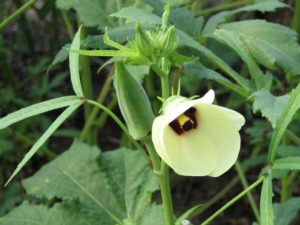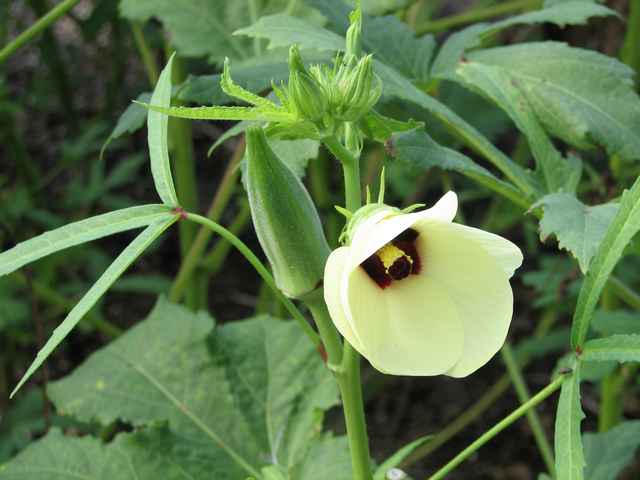Editor’s Note: Written by Stephen Clay McGehee. Reposted with permission from The Southern Agrarian – http://www.southernagrarian.com/

Most of us garden primarily for pleasure. It’s what we do because – well, because we are Southern Agrarians. Yes, what we grow ends up on our table or given to friends and neighbors; however, what our garden produces generally does not determine whether we eat or starve.
But what if it did? What if our very fragile system were to collapse leaving the grocery store shelves empty and the streets too dangerous to venture out in? Part of Southern Agrarianism is being independent of that complex system, so this is very much a topic for discussion.
My garden tends to be planned more around what we enjoy eating and growing rather than for maximizing food production when lives depend on it. The Last Ditch List is what I would be planting if lives did depend on it.
The Southern Agrarian Last Ditch List
Sweet Potatoes (Centennial)
Incredibly easy to grow; I’m still growing them from the very first slips that I got about eight years ago. I keep moving them around to avoid soil-borne pests and diseases, and they will take transplanting without any problem.
ꔷ The taste is delicious
ꔷ High in nutritional value
ꔷ Will last for months if stored in a cool, dark place
ꔷ The leaves are edible
Okra (Clemson Spineless)
ꔷ Continuous production through hot weather
ꔷ Very resistant to disease and pest
ꔷ Each plant will produce one or two edible pods about every two to three days
ꔷ Easy to save seeds
ꔷ Delicious when fried
Eggplant (Florida Highbush)
ꔷ Highly productive through hot weather
ꔷ Easily prepared and makes a good, filling meal
ꔷ Minimal problems from disease or pests
ꔷ Relatively easy to save seeds if you know the technique
ꔷ Should plant a fairly large number to maintain genetic diversity in seeds
Seminole Pumpkin
ꔷ Fruit can last up to a full year when properly stored
ꔷ Almost impervious to disease or pests
ꔷ Huge vines that drop roots along the way making the plant very resilient and able to thrive on relatively poor ground
ꔷ Lots of organic matter at the end of the season to keep the ground rich
ꔷ Needs good care and lots of water to get started; once established, requires almost no care
Collards (Georgia Southern)
ꔷ Winter crop
ꔷ Other greens will not reliably produce seeds in this area
Second Tier crops
These are ones that I am still working with but don’t have enough experience yet to put them on the Last Ditch List. Nothing other than lack of a well established track record keeps me from putting them on the Last Ditch List.
Potatoes (Yukon Gold)
This is only my second time planting these, but all indications are that they should make the Last Ditch List in the next year or two.
Squash (Tromboncino)
The variety makes all the difference. I have given up on the more typical yellow squash; bugs have destroyed them every single time I have tried. Tromboncino, on the other hand, is highly resistant to pests due to its tough outer skin. The fruit is pale green, long and thin, and grows on a vine. I have them growing along a fence.
Not On The List
These are crops that I grow now, but they don’t meet the criteria for inclusion on the Last Ditch List.
Beans (Kentucky Wonder or Blue Lake) – Too many poor results. Sometimes I get a good crop, and other times it’s a poor crop. Inconsistent. May be moved to the Last Ditch List once I learn more, but not yet. Good potential once I learn more.
Corn (Reid’s Yellow Dent) – Low yield for the amount of space it takes up. Heavy drain on the garden soil. If any crops would be available for purchase following a collapse, it would be grains. They are well suited for large scale, highly mechanized farming, and they transport and store well. I keep some seeds on hand for use in corn meal or for chicken feed – just in case.
Tomatoes (Homestead 24) – Too easily damaged by bugs or disease or blossom end rot. They stop producing when the weather gets hot.
Peppers (Carolina Wonder) – Susceptibility to Blossom End Rot keeps peppers off the list. If I can get the calcium deficiency solved, this might be moved to the Last Ditch List.
Final Notes
Vegetable gardening is very location-dependent. This Last Ditch List is what works for me here in north central Florida. There is a really good chance that your Last Ditch List would be different. Maybe very different. Perhaps the most value from this list is in the criteria – why I chose what I did for this list.
What is on your Last Ditch List – and why?
For more content like this, please visit The Southern Agrarian – http://www.southernagrarian.com/










Easiest way to solve the calcium deficiency: head down to Tractor Supply and buy yourself a 50# bag of crushed oyster shell. For less than $10 you can cover hundreds of square feet of garden, and the chunks will give a nice, slow release into the soil. I started adding about a handful to each raised bed every spring and I haven’t had end rot problems in years.
My problem with peppers is the same as green beans: wildly inconsistent. I have one container on the deck kicking out peppers like mad. Ten feet away another pepper is still 6″ tall and hasn’t grown an inch in the last month. Same seed, same soil, same sunlight. It’s maddening. I plant ’em anyway because the result of the good years can be made to last through the bad ones.
I agree with Borack. We always add Oyster shell to the beds at the beginning of each season. As for blossom end rot we haven’t had that in years, We take crushed egg shells, about 20 shells crushed small wrapped in some cheesecloth, soak in a gallon of water in full sun for a couple of days, add the liquid to a small sprayer and spray the blossoms early AM a couple time s a week at the start of the season and no end rot or wilt on tomatoes, peppers, even melon and squash. The only problem is you will have such a strong bloom set natural processes will not thin the blooms so unless you go through and do it yourself you might have a ton of smaller fruit.
This year was the first time we tried growing pumpkins and the results so far are excellent, I will try to get the seminole variety for next season. Thanks for the info Southern Agrarian and for taking the time to write. I never tire of the wonders that God shows me in the garden. I only wish our season was a little longer here in Northern Arizona.
This is a great list, and some important points we don’t often think about.
Both eggplant and okra are also excellent for dehydrating. When rehydrated, they can be used exactly like the fresh product, and you will not be able to taste or see any difference in them. They do so well that I now dehydrate both instead of freezing or canning. That is another element that puts them on top of my “preppers” list.
Garlic and Onions – both “can be” biennial or even perennial crops if left alone. Here in North Central Texas, we have a local variety of elephant garlic that is more like a leek which spreads well and does not require tending. And I want to get a start of potato onions or other spreading, but I have been surprised that when I overlook a few onions at harvest time, they will continue to grow and come back the next year, so I think a permanent bed of them might naturalize to an extent.
I can’t get peppers to produce until fall – they don’t like “hot and dry”. Same with Eggplant- they produce early, then they sit through the summer, and kick into gear again in the fall. Even my little perennial wild pepper: Chile Pequin, doesn’t bear or ripen until fall. It is a woody shrub, some winters the limbs will freeze back, but it sends up new sprouts from the roots.
I have found that the variety makes a world of difference in both peppers and tomatoes. For hot, dry Texas, Porter tomatoes are perfect. They will produce nonstop. If you have trouble with tomatoes, try varieties of cherry tomatoes. They tend to be more prolific and much less susceptible to problems overall.
I’m trying pumpkins for the first time this year and the deer are biting off the blossoms and tiny fruits! My deer netting kept them out fora while but they have figured that out. My next plan is to use an motion activated sprinkler. In a survival state, we would of course sit up all night with a shotgun guarding the garden and add “steak” to our diet. For now, we are in town so we don’t LOL
4.5
5
4.5
[…] Source link […]